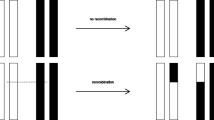Summary
Computer simulation for selective conditions that may apply in nature yielded three generalizations for prokaryotic organisms with recombinant mechanisms. (1) Selective forces can suffice to maintain a tandem gene family with the nearly optimum number of genes with little variance within the population. (2) Tandem genes will occur within the population unless the population is frequently cloned or unless the function due to a single copy is capable of over-providing the needs of the organism. (3) Even when there is no selective advantage or disadvantage due to extra gene copies, the population distribution becomes more skewed with time; and organisms with only single copies of the gene comprise a progressively larger fraction of the total. This may be the case with genes that function under strong cellular regulation.
Evolutionary implications of these calculations are that the occurrence of unequal recombination of tandem genes would greatly slow evolution via duplication of genetic material. This difficulty and its possible resolutions are discussed.
Similar content being viewed by others
References
Anderson, R.P., Roth, J.R. (1977). Ann. Rev. Microbiol.31, 473–505
Anderson, R.P., Miller, G.C., Roth, J.R. (1976). J. Mol. Biol.105, 201–218
Beeftinck, F., Cunin, R., Glandsdorff, N. (1974). Mol. Gen. Genet.132, 241–253
Black, J.A., Gibson, D. (1974). Nature250, 327–328
Crow, J.F., Kimura, M. (1970). An introduction to population genetics theory. New York: Harper
Davison, E.H. (1976). Gene activity in early development. New York: Academic
Falkow, S. (1975). Infectious multiple drug resistance. London: Pion
Feller, W. (1968). An introduction to probability theory and its application. Vol.1, 3rd ed. New York: John Wiley
Hansche, P.E., Beres, V., Lange, P. (1978). Genetics88, 673–687
Hood, L. (1976). Federation Proc.35, 2158–2161
Jackson, E.N., Yanofsky, C. (1973). Ann. Rev. Microbiol.31, 473–505
Koch, A.L. (1972). Genetics72, 297–316
Koch, A.L. (1974). Genetics77, 127–142
Novick, A., Horiuchi, T. (1961). Cold Spring Harbor Symp. Quant. Biol.26, 234–245
Novick A., Weiner, M. (1957). Proc. Natl. Acad. Sci.43, 553–556
Ohta, T. (1978). Genetics88, 845–861
Reanney, D.C. (1976). Bacteriol. Rev.40, 552–590
Smith, G.P. (1974). Cold Spring Harbor Symp. Quant. Biol.38, 507–513
Thomas, C.A., Jr. (1970). In: The Neurosciences: Second Study Program, F.O. Schmitt, ed., p. 973. New York: Rockefeller University Press
Witten, M. (1975). Growth kinetics of tandem multiplicate genes: A possible model for the evolution of macromolecular complexities. Master thesis submitted to Biophysical Sciences at State University of New York at Buffalo
Author information
Authors and Affiliations
Additional information
Supported by the U.S. AEC under contract No. W-31-109-ENG-38.
Rights and permissions
About this article
Cite this article
Koch, A.L. Selection and recombination in populations containing tandem multiplet genes. J Mol Evol 14, 273–285 (1979). https://doi.org/10.1007/BF01732495
Received:
Issue Date:
DOI: https://doi.org/10.1007/BF01732495




